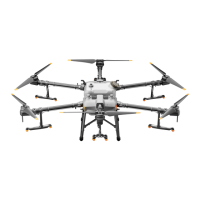Contents [ hide
1 Safety at a Glance
2 Notice
3 Glossary
4 Pre-Flight Checklist
5 Disclaimer and Warnings
6 Individual Parts
7 Flight Battery
8 Compass
9 Propulsion System
10 Spraying System
11 Spherical Radar System
12 Firmware
13 DJI Agras App
14 4G Dongle
15 Product Care
16 Maintenance
17 Flight Condition Requirements
18 Operating the Aircraft Responsibly
19 Operation Modes
20 Compliance with Regulations & Flight
Limits
21 Flight Limits
22 Export Controls
23 Export Compliance, Disclaimer & Indemnity
24 Compliance Information
25 File Downloads
26 Related Manuals
Safety at a Glance
The AGRASTM T30/T10 aircraft is not a toy and is not suitable for children under the age of 18. Note that the
Safety at a Glance section only provides a quick overview of the safety tips. Make sure you read and understand
this document and the Agras T30/T10 User Manual.
1. Pesticide Usage
Avoid the use of powder pesticides as much as possible as they may reduce the service life of the
spraying system.
Pesticides are poisonous and pose serious risks to safety. Only use them in strict accordance
with their specifications.
Residue on the equipment caused by splashes or spills when pouring and mixing the pesticide can
irritate your skin. Make sure to clean the equipment after mixing.
Use clean water to mix the pesticide and filter the mixed liquid before pouring into the spray tank to
avoid blocking the strainer. Clear any blockage before using the equipment.
Make sure to stay in an upwind area when spraying pesticide to avoid bodily harm.
Wear protective clothing to prevent direct body contact with the pesticide. Rinse your hands and skin
after handling pesticides. Clean the aircraft and remote controller after applying the pesticide.
Effective use of pesticides depends on pesticide density, spray rate, spray distance, aircraft speed,
wind speed, wind direction, temperature, and humidity. Consider all factors when using pesticides,
but DO NOT compromise the safety of people, animals, or the environment in doing so.
DO NOT contaminate rivers and sources of drinking water.

